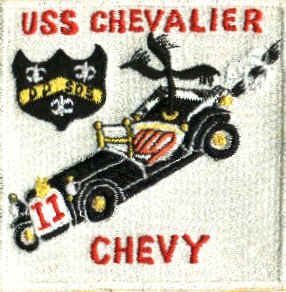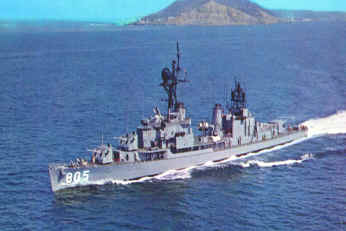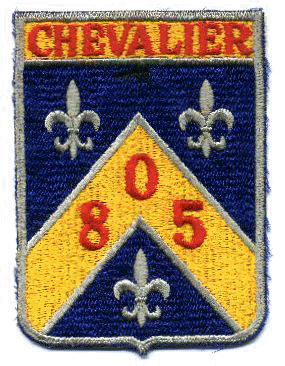|

BOILER FLAT BALLET
By Richard H. King, CDR USNR-Ret.
At the time of this story, CDR King was LT
JG, Main Propulsion Assistant (1965-1968),
(Assistant Engineering Officer for Main Propulsion)
U.S.S. CHEVALIER (DD-805)
 On modern gas turbine ships, the engine speeds and prop pitches can be
controlled remotely from the bridge. When
docking such ships, the Conning Officer’s commands are instantly converted
into a response at the propellers. That
is not the way it was on a Gearing Class Destroyer, the Navy’s
last destroyers with 100% manual control.
On modern gas turbine ships, the engine speeds and prop pitches can be
controlled remotely from the bridge. When
docking such ships, the Conning Officer’s commands are instantly converted
into a response at the propellers. That
is not the way it was on a Gearing Class Destroyer, the Navy’s
last destroyers with 100% manual control.
In Gearing Class engine rooms, the action in docking was at
the throttle board where there was a big valve wheel that controlled the steam
to the ahead turbines (high pressure “HP” and low pressure “LP” geared
together), and a smaller wheel that controlled the steam to the astern turbine
blades inside the LP turbine. Typically
the throttles were controlled by an E-3, sometimes an E-4 for special sea
details. The starboard shaft was driven from the forward engine room
and forward throttle board, the port shaft from the after engine room. Each
of the two “throttle men” were concerned only with his respective turbines
and shaft.
Assume that a shaft is turning ahead one third and the
annunciator suddenly “clangs” and switches to “astern
one third”. The throttle man would immediately crack open the astern
valve and then close the ahead valve as fast as he could. Then he would quickly switch his hands to the astern valve
and open it some more. Using
a mirror mounted so he could see the “barber shop” stripes painted on the
shaft, when the shaft stopped he would then open the astern valve in
earnest until the shaft was turning backwards at the proper number of rpm’s.
Of course during a docking these orders from the bridge would come in
fast and furious, sometimes faster than he could keep up. As a general rule of
thumb, the experience level of the conning officer was inversely proportional to
the number of commands it took to dock the ship (i.e., a more experienced
conning officer could dock the ship with fewer commands).
 The action in the engine rooms during docking, however, was
nowhere near as exciting as the action in the boiler rooms. One
reason for this was the turbine set-up. “Ahead”
steam entered first the HP turbine and upon exiting there next went to the LP
turbine. Between those two
turbines, there were many, many turbine blades.
For “astern”, there were simply a few blades on either end of the LP
turbine set backwards from all the rest. The
“astern” valve shot steam directly to those astern blades.
Consequently, it took two or three times as much steam
to go “back one third” as it did to go “ahead one third”.
The action in the engine rooms during docking, however, was
nowhere near as exciting as the action in the boiler rooms. One
reason for this was the turbine set-up. “Ahead”
steam entered first the HP turbine and upon exiting there next went to the LP
turbine. Between those two
turbines, there were many, many turbine blades.
For “astern”, there were simply a few blades on either end of the LP
turbine set backwards from all the rest. The
“astern” valve shot steam directly to those astern blades.
Consequently, it took two or three times as much steam
to go “back one third” as it did to go “ahead one third”.
As the conning officer yo-yoed between ahead and astern
commands trying to maneuver the ship along side the pier, his orders were also
“annunciated” in the fireroom. The
protocol (at least on Chevalier) was that everyone in the fireroom who heard the
“clang” and/or saw the arrow jump to a new position would yell out the new
command as loud as he could “back one third!”
On the “boiler flat” (the lower level between the two boilers), it
was time to get busy. For an
“astern” bell, the burner man (under the watchful eye of the top watch)
would need to cut in some more burners as fast as he could. He had a pressure
gauge in front of him, which he had to hold as close to 600 PSI as possible.
At 610 PSI he was going to start blowing safety valves and at about 590 PSI,
he would be approaching a phenomena called “dragging down
the boiler” and a total loss of control.
 The top watch himself was also busy; he needed to speed up
the forced draft boilers to greatly increase the amount of air to the boiler to
match its sudden increase in firing rate (and avoid making smoke).
By looking through a periscope (the business end of which was in the
stack) the top watch could observe how smoky it was and the color of the smoke.
Black smoke meant “not enough air”
and white smoke meant “too much air”.
A clear or almost clear stack meant
“just right”.
The periscope was the top watch’s primary indicator if he was feeding
the boiler the right amount of air although there was also a gauge showing the
air pressure in the boiler casing. Really experienced men could also match the
sound (the “pitch of the whine of the blowers”) with a bell order.
The top watch himself was also busy; he needed to speed up
the forced draft boilers to greatly increase the amount of air to the boiler to
match its sudden increase in firing rate (and avoid making smoke).
By looking through a periscope (the business end of which was in the
stack) the top watch could observe how smoky it was and the color of the smoke.
Black smoke meant “not enough air”
and white smoke meant “too much air”.
A clear or almost clear stack meant
“just right”.
The periscope was the top watch’s primary indicator if he was feeding
the boiler the right amount of air although there was also a gauge showing the
air pressure in the boiler casing. Really experienced men could also match the
sound (the “pitch of the whine of the blowers”) with a bell order.
Especially
when a klutz OOD (like the author of this article) was trying to dock the ship,
the “bells” came fast and furious; “Ahead!
Stop! Back! Ahead!”.
The antics on the boiler flats became almost a form of
dance as the men controlling the boilers tried to keep up.
Some BT’s were better and more skillful at this “art form” than
others, and it was exciting and fun to watch real pros in action, doing
the “Boiler Flat Ballet”.

Please note: The two boiler rooms, the two engine rooms, two emergency diesel
generator rooms, various small pump rooms, the shaft alleys, fuel and
water tanks, machine shop, electrical workshop, shipfitter's shop,
engineering log room, Oil King's Shack, engineering berthing compartment,
the stacks, ventilation blower voids etc, were considered "Snipe
Country". This only applied to FRAM Destroyers!

 

|
